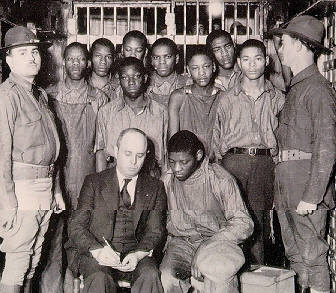On March 25, 1931, nine black youths ages 13-19 were arrested for rape in Alabama. The Scottsboro Boys became famous as a case of racial injustice that shone a light on the treatment of blacks in the South. The nine had been traveling on a train as hoboes when they had a fight with some white youths. The blacks won and the whites were ejected from the boxcar. They complained to the police and at the next stop the cops were eagerly waiting. The nine were arrested and would have been charged with assault, but then two young “ladies” entered the story. Victoria Price (21 years old) and Ruby Bates (17) claimed that they had been raped by the blacks. The boys were jailed where a mob threatened to lynch them. The National Guard had to be called in. The trial was held in Scottsboro. The star witness was Price. Enjoying the attention, she described the rapes that had left her unperturbed at the time of the arrests. She described the marks of assault that were not present when she was examined by a doctor. Nor did the doctor find evidence of rape. In spite of what was clear perjury, the all-white, all-male jury took little time in convicting the Scottsboro Boys. At this point the American Communist Party got involved and assigned its International Labor Defense (ILD) team to the case. It launched a national campaign to demand a retrial. Although the Alabama Supreme Court upheld the convictions, the U.S. Supreme Court granted retrials based on denial of the right to counsel. A Judge James Horton presided. Price was the star witness again, but in a shocking development Ruby Bates recanted. She testified that Price had concocted the story to avoid their own arrest for prostitution. However, Bates admitted her nice clothes had been purchased by the ILD, so the jury disregarded everything she said. But the judge believed her and the medical examiner who testified that there had been no signs of rape. When the all-white jury again found them guilty, Horton suspended the sentences and ordered a retrial. He was subsequently defeated for reelection. The new judge was a more typical Southern judge. The new trials reaffirmed guilt and the Alabama Supreme Court upheld again. In 1935, in Norris v. Alabama, the U.S. Supreme Court overturned due to the lack of black in the jury pool. Eventually, all of the boys were released, but after years in prison for a crime they did not commit. In 2013, the Governor of Alabama pardoned them. Supposedly, Harper Lee was inspired by the first trial to write “To Kill a Mockingbird”.
https://www.history.com/topics/great-depression/scottsboro-boys
https://www.aclu.org/issues/racial-justice/saga-scottsboro-boys
https://en.wikipedia.org/wiki/Scottsboro_Boys

0 Comments